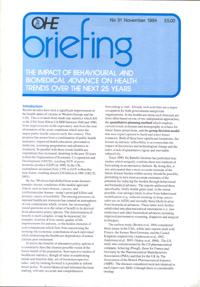Sign up to our newsletter Subscribe
Analysing Global Immunisation Expenditure

Recent decades have seen a significant improvement in the health status of citizens in Western Europe and the USA. This is evident from death rate statistics which fell in the USA from 10.6 to 5.4/1000 between 1940 and 1990, from improvements in life…
Recent decades have seen a significant improvement in the health status of citizens in Western Europe and the USA. This is evident from death rate statistics which fell in the USA from 10.6 to 5.4/1000 between 1940 and 1990, from improvements in life expectancy, and from the near elimination of the acute conditions which were the major public health concern early this century. This progress has arisen from a combination of public health measures, improved health education, preventative medicine, screening programmes and advances in treatment. In parallel with these trends healthcare expenditure has increased, doubling in the past 30 years within the Organisation of Economic Co-operation and Development (OECD), reaching 9.0% of gross domestic product (GDP) by 1990. In the UK, expenditure increased from 3.9% to 6.6% within this time frame, totalling almost £38 billion in 1991 (OECD, 1993).
By the ’90s focus had shifted from acute diseases towards chronic conditions of the middle aged and elderly such as heart disease, cancers, and cerebrovascular disease—today’s principal killers and primary causes of morbidity. The ensuing pressures on national healthcare resources has created an atmosphere of cost containment which, in turn, has increasingly raised questions as to the value or benefit to be derived from alternative policy options. The determination of benefit is itself complex: it may be measured, for example, in terms of lives saved, quality of life improvements for patients, or the hidden elements of cost-containment which flow from maximising the working-life economic contribution of each individual while minimising the healthcare dependency of senior citizens post retirement.
To assess the benefits of alternative policy options it is essential to have the clearest possible vision of the future health of the population. Retrospective studies of healthcare statistics, though of value in establishing trends and baseline data, are of limited prospective value: only by looking forward is it possible to inform future policy. To assist balanced and informed decision making, relevant, accurate and comprehensive forecasting is vital. Already such activities are a major occupation for both governments and private organisations. In the healthcare arena such forecasts are most often based on one of two independent approaches, the quantitative planning method which employs current trends in disease and demography as a basis for linear future projections, and the group decision model that uses expert opinion to build and select future scenarios. Both of these have significant limitations, the former an intrinsic inflexibility to accommodate the impact of discoveries and technological change and the latter, a lack of quantitative rigour and inevitable subjectivity.
Since 1990, the Battelle Institute has published four studies which uniquely combine these two methods of forecasting in an interactive fashion. By doing this, it was anticipated that a more accurate estimate of the future disease burden within society should be possible, permitting in turn more accurate estimates of the potential for reducing the burden through behavioural and biomedical advance. The reports addressed these specifically, firstly health gains (and, to the extent possible, cost savings) likely to arise from behavioural modification (e.g. reduced smoking on lung cancer; safer sex on AIDS) and secondly those likely to arise from biomedical advances. These latter were further subdivided into pharmaceutical innovations (i.e. new medicines) and other biomedical advances including improved preventative screening, diagnosis and surgical techniques.
The earliest study (Brown et al, 1991) considered these issues in the USA, while later reports dealt with France, the former West Germany and the United Kingdom respectively (Andersson et al, 1992; Andersson etal, 1993; Oleksy etal, 1994). The US study was commissioned by the US pharmaceutical company, Schering-Plough, those for France and Germany by the Pharmaceutical Manufacturers Association (PMA) and that for the UK by The Association of the British Pharmaceutical Industry (ABPI). The diseases considered were not identical in each report though there is considerable overlap.
The specific purposes of the UK study were to (i) estimate the extent to which advances in biomedical technology and changes in health-related behaviour will affect the future health status of UK citizens and (ii) predict the number of cases and deaths from six major diseases that may be avoidable. The underlying objective was to help policy-makers make rational decisions regarding investment in public health measures and technology development aimed at improving health in the UK population.
In this briefing we:
• discuss the methods employed in the Battelle studies, including caveats to interpretation,
• summarise the data presented and the conclusions drawn from the UK study, identifying areas where there appears to be the greatest opportunity for behavioural change and biomedical advance,
• compare the UK results with those from other studies,
• consider the value of this approach for healthcare planning.
The Impact of Behavioural and Biomedical Advance on Health Trends over the Next 25 Years


